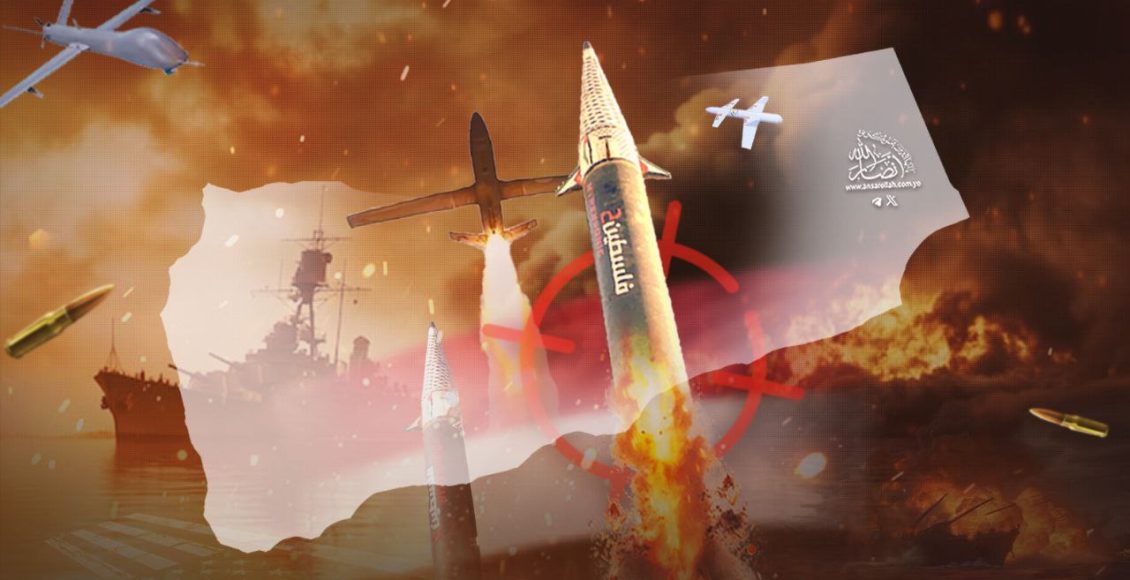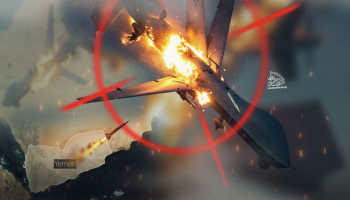Perhaps fate reserved a harsh lesson for the previous U.S. administration and its allies. Yemen — the country once underestimated — has emerged as a powerful regional player, proving that resistance breeds strength. Years of war and ongoing aggression have not weakened the will of the Yemeni people as some assumed; instead, they have sharpened it, turning Yemen into a formidable actor in the struggle against tyranny.
The truth is gradually unfolding, exposing the falsehoods behind U.S. claims of having subdued Yemeni strength. Admissions from Washington itself have pointed to the failure of its military strategies. Rather than quelling the resistance, these strategies ignited its flames and elevated Yemen’s strength and presence. While the war machine churned, Yemenis demonstrated legendary determination, leaving the United States and its allies mired in a swamp of strategic failure.
Within this complex landscape, Yemen has asserted itself as a force to be reckoned with — reshaping regional conflict dynamics, making support for the Palestinian cause a unifying pulse among the free, and granting Yemeni actions unprecedented legitimacy and sympathy. As Sayyid Abdul-malik Badruldeen al-Houthi affirmed, the American escalation has failed to secure maritime navigation for the Israeli enemy or to weaken Yemeni military capabilities — rather, it has contributed to their advancement. The American aggression will not affect the Yemeni people’s will, morale, or resolve. On the contrary, the unified effectiveness of the Yemeni position — militarily, popularly, and officially — is what drives the American enemy to exert maximum pressure in an attempt to undermine it.
Pentagon Haunted by the Yemeni Power Puzzle
In the corridors of the U.S. Department of Defense (Pentagon), a cold anxiety lingers. According to a report by the Russian newspaper Svobodnaya Pressa, Yemen’s growing military strength, particularly its missile and drone capabilities, has transcended the level of a mere threat to U.S. interests, becoming an intelligence enigma. Western intelligence agencies, including the U.S. Defense Intelligence Agency, the Israeli enemy’s Mossad, and British intelligence, have encountered a wall of secrecy surrounding Yemen’s arsenal. Two years of intensive aerial operations and targeted strikes have failed to erode the military infrastructure of Yemeni forces.
The greatest shock came when Yemen, after entering the Red Sea battle in support of Gaza, successfully closed this vital artery to Israeli, American, and British ships through precise and painful strikes. This feat shook Washington to its core. A senior Pentagon official admitted, as cited by the paper, that the U.S. lacks accurate intelligence about Yemen’s real capabilities.
The report adds that the Yemenis have not only relied on "Qaher-1" and "Burkan-1" missiles but have acquired a diverse arsenal of medium- and long-range missiles — some developed from Soviet models and others, as the Yemenis affirm, entirely domestically produced. This includes cruise missiles and advanced coastal defense systems. Yet what troubled the Pentagon most was not the size of the arsenal, but the systematic transformation of Yemeni forces from an armed movement into a structured army with specialized units, ground and missile forces with precise missions, and steadily advancing drone technology — heralding a potential shift in the rules of engagement.
Trump’s War Turns into a Nightmare for Washington
Reflecting the resilience of the Yemenis, The Atlantic warned that “Trump’s war against the Houthis may become a scandal for America,” noting that Yemeni forces have emerged from every battle “stronger” and are preparing to declare “a historic victory over the Biggest Satan” if U.S. failures persist. The story began with a seasoned U.S. general admitting the complexity and gravity of the Yemeni threat, describing it as “the most intricate and dangerous.” This admission dismantled earlier U.S. narratives that downplayed Yemeni capabilities, instead highlighting their remarkable ability to regroup and use inexpensive drones to inflict severe damage on the U.S. Navy.
The New York Times, citing Pentagon officials, confirmed that efforts to destroy the Houthis' massive arsenal have not succeeded. Despite massive defense spending and the strengthening of Yemeni positions, the U.S. has failed to meet its objectives. Trump’s campaign ended in outright failure, bolstering the Yemeni Armed Forces and their regional influence, reflecting a gross miscalculation of Yemeni strength and a shift in the balance of power.
The U.S. Secretary of State’s call for an “international coalition” to confront and criminalize the Houthis underscored rising concerns about Yemen’s expanding power and America’s inability to deal with it alone.
U.S. Struggles to Understand Its Adversary
The American military website Task & Purpose described the situation as “difficult and unfamiliar,” noting that the scale of fire faced by the U.S. Navy is “unprecedented” and is depleting its capabilities.
Meanwhile, The National Interest went further, stating that “the Houthis have placed the United States in a strategic bind,” that the Navy is “exhausted,” and that its reliance on expensive aircraft carriers is “ill-suited to this new era,” signaling a clear failure to adapt to changing dynamics.
The U.S. Navy’s Fragility Exposed
Task & Purpose published a report highlighting one of the most pressing dilemmas currently facing the U.S. Navy: the rapid depletion of its missile stockpile in the Red Sea amid constant threats from the Yemeni army as part of “Operation Noble Knight.”
The report stated that “the U.S. Navy is now engaged in the longest stretch of continuous naval combat since World War II,” facing 21st-century threats directly in an operational environment not encountered in generations. Most of these threats — aside from outdated missiles — had previously only been dealt with in exercises or simulations, not at this intensity or duration, creating a new combat reality.
According to the report, from October 2023 to January 2025, the U.S. Navy underwent the longest and fiercest series of maritime confrontations since World War II, firing nearly 400 missile rounds at Houthi targets and over 160 five-inch artillery shells at drones and nearby threats that missiles could not effectively counter.
The report pointed to an “uncomfortable truth”: the U.S. Navy is more vulnerable to prolonged attrition than previously believed, especially in high-intensity combat zones like the Red Sea.
Retired U.S. Navy Commander Bryan Clark was quoted as saying, “The cost was considerable.” He added that the scale of fire and unconventional tactics encountered represented a dramatic shift from previous combat environments familiar to U.S. forces.
The experience, the report noted, has prompted the Navy to reconsider its defensive strategies, gradually pivoting toward greater use of naval guns and conventional weapons, having realized that exclusive reliance on missiles in such high-intensity environments poses a strategic risk to operational sustainability.
U.S. Deterrence Faltering
According to The National Interest, “The U.S.-led military campaign against the Houthis in the Red Sea may fail to achieve its objectives unless the errors that hampered earlier operations are corrected — a prospect that appears doubtful according to recent Pentagon reports.”
The article noted that despite America’s massive spending — approximately $4.86 billion — and the loss of advanced drones like the MQ-9 Reaper to inexpensive missiles and drones, Washington has yet to regain its lost deterrence. The analysis, authored by Chad Konkel, stressed that “operations in the Red Sea are depleting costly and scarce munitions needed in more strategically vital regions like the Indo-Pacific.” While “the Houthis use cheap but effective drones and missiles, the U.S. risks losing more than $30 million MQ-9 Reapers,” he added. “The Houthis have proven remarkably resilient in sustained aerial campaigns.”
The article concluded that unless the Pentagon, under President Trump’s leadership, finds a way to resolve the issues plaguing past operations, which seems unlikely given recent defense official reports, the current administration could face similar failures, further eroding U.S. credibility if results are not delivered swiftly. The author noted that even if this campaign succeeds in temporarily halting attacks on American vessels, its effects may not be lasting.
A Growing Acknowledgment of Strategic Realities
These reports collectively reflect a growing realization within the enemy camp of three key facts. First, the efforts by the Trump administration to deter Yemen are unlikely to significantly impact the strength, resolve, or momentum of Yemen’s support front. Second, the imbalance between massive resources and limited, often negligible outcomes will persist in any aggressive strategy against Yemen, including any “broad regional coalition” approach, due to the impossibility of achieving a “swift resolution.”
The third, and most deliberately ignored fact by the Zionists, is that the problem is not merely the absence of tools or strategies to deter Yemen. Rather, the far more alarming issue is the continued evolution of Yemeni military capabilities, which consistently demonstrate their growing presence on the battlefield. Thus, any proposed strategic adjustments are effectively meaningless, as the “lengthy time” required for their implementation itself creates a massive gap in any strategy, one that is only widened by the constant upward trajectory of Yemen’s military development.







